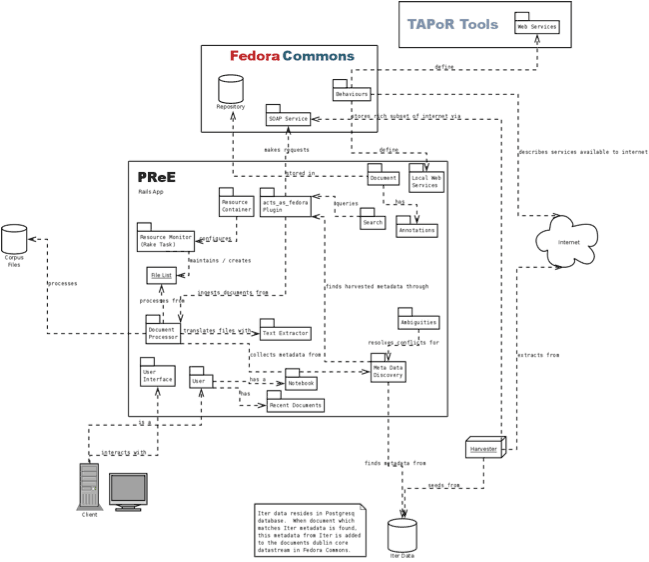| << Chapter < Page | Chapter >> Page > |
With new development paths come new questions and concerns. For example, how would we provide consistent metadata for widely disparate sources? To address this, we are investigating the possibility of using natural language processing tools (NLP) to discover key information points within the document, and then using this information to do a lookup within a robust metadata database. At the time of writing, metadata for our documents is stored inside the database structures. The documents are transformed into HTML or plain-text equivalents, which are then fed into Solr through its REST web interface. PReE uses Solr’s REST API to provide full-text searching, handing off each search request to Solr and converting the search results into HTML for the browser.

A high level architectural diagram ( Figure 7 ) was created that situated the Crawler (marked ‘Harvester’) within the intended rebuild of REKn and PReE. As suggested by the diagram, we maintained the belief that integration with Fedora Commons was the ideal solution (see Appendix 3 ), but that we would have to wait until the technology allowed.
Users are beginning to expect more from web applications than ever before. Social networking tools and the “Web 2.0” pattern of design has given web application developers many new ways of building knowledge into their applications. By adopting a web-application model for PReE, we could tie into existing social networking tools and begin to innovate with the creation of new tools designed specifically for the professional reader. The decision to include social networking capabilities in the PReE design was based on research conducted by the Public Knowledge Project (PKP) into the reading strategies of domain-expert readers (a subset of professional readers). See Siemens et al. (2006) and “It May Change My Understanding of the Field,” forthcoming. Like PReE, the goal for the reading tools developed by PKP was to provide access to research and scholarship and to support critical engagement with those materials. During interviews conducted by PKP and ETCL researchers, expert readers identified the ability to communicate with other researchers as an important benefit of an online reading environment. These readers also expressed interest in contextual information that would help them judge the value of an author’s work. From these observations, researchers concluded that future online reading environments would need to provide the kind of communication and profile-management features currently offered by social networking tools.
Before adding social networking components to the PReE features list, we researched existing social networking tools and their use by expert readers (Leitch et al. 2008). Based on evidence gathered during the PKP study we determined that as expert readers became adept at using online tools, they would demand a higher level of sophistication from an online reading environment. In order to respond to this increasing awareness of the potential of social networking tools for scholarly research, a successful online reading environment should integrate social networking tools in such a way that it extends the readers’ existing research strategies. We identified three key strategies that readers used as part of their research: evaluating , communicating , and managing . Our survey found that no single social networking tool supported all three of these strategies. An environment able to facilitate all three strategies would be of immense value to the expert reader, who would not be forced to use a variety of disjointed social networking tools. Instead, he or she would be able to perform the same tasks from within the reading environment.

Notification Switch
Would you like to follow the 'Online humanities scholarship: the shape of things to come' conversation and receive update notifications?